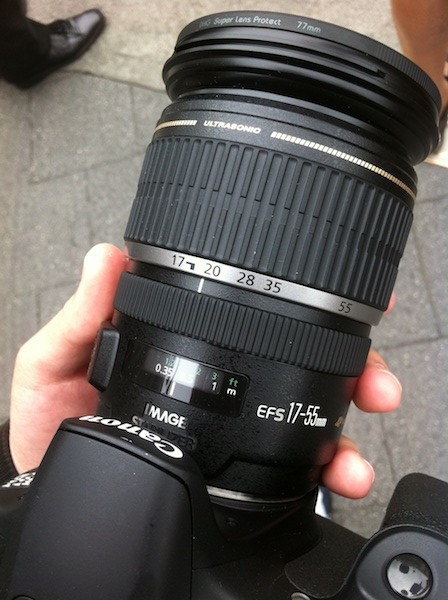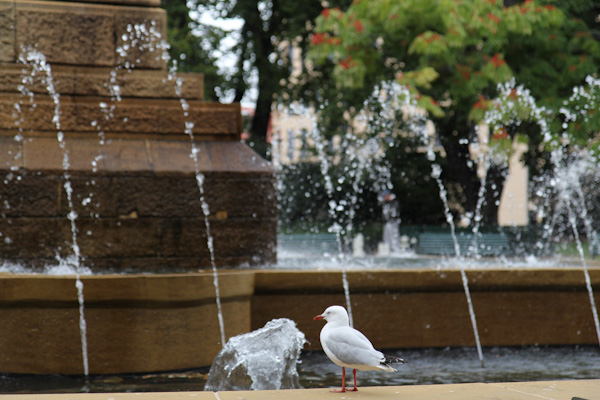Yes, photography. Another day, another lens.
Wait, what?
I have a confession to make. I’ve been suffering from GAS (Gear Acquisition Syndrome, for the uninitiated) for a little while now, which results in me buying lots of things. Perennially bad for my wallet, but somewhat satisfying. What good is money if you don’t spend it?1
My newest glass is the arguable best of EF-S lenses for crop-sensor DSLRs, the EF-S 17-55 f/2.8 IS USM. I didn’t find the DigitalRev hands-on to be all that informative (strange for them, their videos are usually top notch when they’re not fooling around doing stupid things like “horsemanning”).

Of course, this meant that I had to try it out. More street, anyone? The location: in and around the Hobart CBD. It was a pretty overcast day which normally would have been fine for a bit of outdoor street, but it started to drizzle heavily a little later on which meant I didn’t go for a serious walk up to North Hobart like I was originally planning to. The best laid plans, and all that.
Initial impressions of the lens: it has a pretty big lens hood (not included). The focal length ring is incredibly, incredibly smooth; there’s a tiny more friction in the 17-35 range than there is in the 35-55 range, which makes it very nice to use. The IS and AF switches have a nice, audible “click” when you move them, and the focal ring is equally smooth when you’re changing the focus, and slightly more resistive when you’re past the focal range adjustment. I honestly can’t fault it as a piece of engineering, bar for the fact that it’s slightly larger than I expected (both length and girth-wise), but I guess that’s part of the parcel when you have quality glass.

It is, in a word, excellent. Most of my flawed photos were simply and error of the guy behind the glass overestimating his abilities to take a good photo — or just simply failing to take a good photo. By my own account, I think I’m at least okay with the whole composition thing — it’s just taking the shot like I see it in my head that’s hard (well, of course it is).
Choosing this lens was difficult, to say the least. I already have comparable lenses that do the same focal range — my Sigma 30 1.4, for example, covers the same distance provided I take a few steps forward or back, and it does this at an even bigger aperture, and I already have an 18-135 which covers the same range, as well as the nifty fifty which does a similar thing to the Sigma. My current collection of glass aside, there were also many great alternatives: the 24-105 f/4L at the top of that list, followed by a few non-Canon alternatives. After taking a few photos with it, I’m pretty glad I chose this lens over something like the 24-105 f/4, purely because it’s a fantastic standard lens for a crop-sensor DSLR.

Admittedly, the 24-105 does still have a few advantages over the 17-55 — it covers a bigger range and works with full-frame cameras should I ever decide to upgrade, both excellent points to consider. It does have one thing lacking though, and that’s the 2.8 aperture. I think this means that it needs twice as much light at the same shutter speeds as the 2.8, and it might also mean I don’t get as much bokeh as I do with a 2.8 aperture (although, once again, it can be argued that the 24-105 can get more bokeh due to its longer focal length). At least, that’s what I’ve gleaned from the internet.
If there’s one thing I want to work on with my street, it’s individual portraits. I’m way too hesitant to take photos of individuals or couples when doing street as it can seem a little stalker-ish, a little perverted (if you’re talking photos of the opposite sex), and there’s already a million other things to worry about when doing street. I guess it’s about finding the line between invading someone’s privacy (if only for a moment) and being seen as a pervert — an exceptionally fine line indeed. Taking photos of individuals on the street is definitely something I’m warming up to, but I’m still quite hesitant about it for the reasons posted above. Sadly, for now, it means my photos aren’t of anything particularly interesting. I mean, who wants pictures of just nothing in particular?

You probably wouldn't want to go where that bus is going, though.
Now that I think about it, taking photos of random people is hard. You never quite know how they might react, and I’ve read enough horror stories to know what could happen. Worst-case scenarios rarely happen, but I’m still a little freaked out one day someone is going to completely lose the plot when I take their photo and, like beat me up or something. It’s a scary thought.
Then I see people like this guy doing street photography on the streets of LA, where he gets right up into people’s faces using his Leica M, and people look up, smile, and continue on with whatever they’re doing. Are people much friendlier over there, or is it all about the right approach? Which brings me to my next point…
Okay, so I’m Asian, right (don’t laugh, this is SERIOUS BUSINESS). On the one hand, I can blend great into any crowd with a decent-sized cam and people will think I’m just another tourist taking pictures of damn-near everything, which is fine. Great, in fact — people don’t think twice about the Asian guy taking a photo of a busker. The only thing is, the whole blending-in thing doesn’t quite work if you’re taking photos of people. I mean, normally you see Asian tourists with their point and shoots snapping away at nice-looking buildings or whatever, and here I am with my giant DSLR aimed squarely at them! What’s up with that?!
Anyway.
Lastly (until next time) I went to the cricket the other day. This was at 85mm on a 1.6 crop — there’s a 200mm lens limit condition of entry at that particular ground, but a) I think the guys at the gate wouldn’t be able to tell (or they just didn’t care because it wasn’t an international match), and b) I think you would be able to get a few decent shots of players if you had something like a 70-200 at the same crop factor.





















